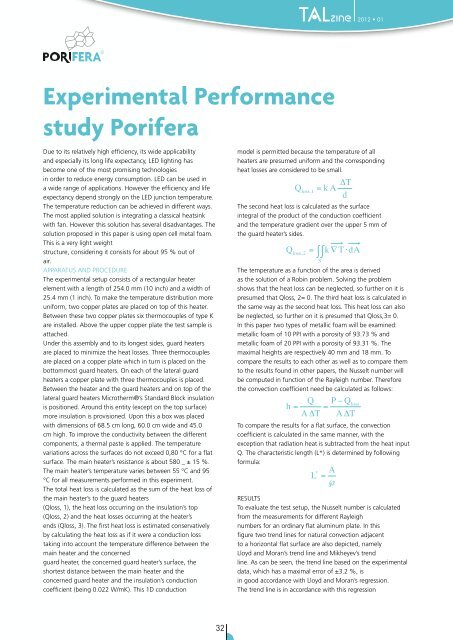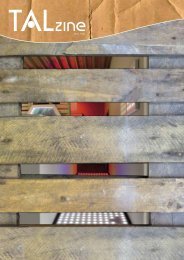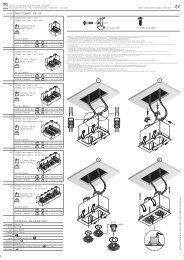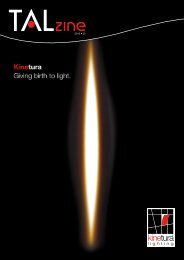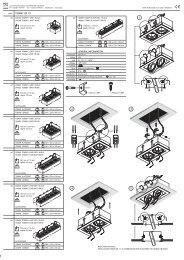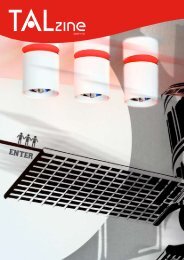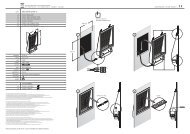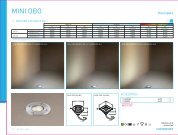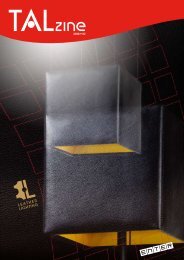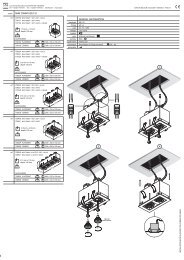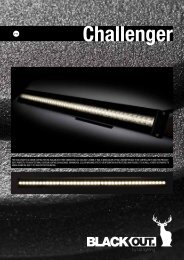You also want an ePaper? Increase the reach of your titles
YUMPU automatically turns print PDFs into web optimized ePapers that Google loves.
Experimental Performance<br />
study Porifera<br />
Due to its relatively high efficiency, its wide applicability<br />
and especially its long life expectancy, LED lighting has<br />
<strong>be</strong>come one of the most promising technologies<br />
in order to reduce energy consumption. LED can <strong>be</strong> used in<br />
a wide range of applications. However the efficiency and life<br />
expectancy depend strongly on the LED junction temperature.<br />
The temperature reduction can <strong>be</strong> achieved in different ways.<br />
The most applied solution is integrating a classical heatsink<br />
with fan. However this solution has several disadvantages. The<br />
solution proposed in this paper is using open cell metal foam.<br />
This is a very light weight<br />
structure, considering it consists for about 95 % out of<br />
air.<br />
APPARATUS AND PROCEDURE<br />
The experimental setup consists of a rectangular heater<br />
element with a length of 254.0 mm (10 inch) and a width of<br />
25.4 mm (1 inch). To make the temperature distribution more<br />
uniform, two copper plates are placed on top of this heater.<br />
Between these two copper plates six thermocouples of type K<br />
are installed. Above the upper copper plate the test sample is<br />
attached.<br />
Under this assembly and to its longest sides, guard heaters<br />
are placed to minimize the heat losses. Three thermocouples<br />
are placed on a copper plate which in turn is placed on the<br />
bottommost guard heaters. On each of the lateral guard<br />
heaters a copper plate with three thermocouples is placed.<br />
Between the heater and the guard heaters and on top of the<br />
lateral guard heaters Microtherm®’s Standard Block insulation<br />
is positioned. Around this entity (except on the top surface)<br />
more insulation is provisioned. Upon this a box was placed<br />
with dimensions of 68.5 cm long, 60.0 cm wide and 45.0<br />
cm high. To improve the conductivity <strong>be</strong>tween the different<br />
components, a thermal paste is applied. The temperature<br />
variations across the surfaces do not exceed 0,80 °C for a flat<br />
surface. The main heater’s resistance is about 580 _ ± 15 %.<br />
The main heater’s temperature varies <strong>be</strong>tween 55 °C and 95<br />
°C for all measurements performed in this experiment.<br />
The total heat loss is calculated as the sum of the heat loss of<br />
the main heater’s to the guard heaters<br />
(Qloss, 1), the heat loss occurring on the insulation’s top<br />
(Qloss, 2) and the heat losses occurring at the heater’s<br />
ends (Qloss, 3). The first heat loss is estimated conservatively<br />
by calculating the heat loss as if it were a conduction loss<br />
taking into account the temperature difference <strong>be</strong>tween the<br />
main heater and the concerned<br />
guard heater, the concerned guard heater’s surface, the<br />
shortest distance <strong>be</strong>tween the main heater and the<br />
concerned guard heater and the insulation’s conduction<br />
coefficient (<strong>be</strong>ing 0.022 W/mK). This 1D conduction<br />
32<br />
2012 • 01<br />
model is permitted <strong>be</strong>cause the temperature of all<br />
heaters are presumed uniform and the corresponding<br />
heat losses are considered to <strong>be</strong> small.<br />
The second heat loss is calculated as the surface<br />
integral of the product of the conduction coefficient<br />
and the temperature gradient over the upper 5 mm of<br />
the guard heater’s sides.<br />
The temperature as a function of the area is derived<br />
as the solution of a Robin problem. Solving the problem<br />
shows that the heat loss can <strong>be</strong> neglected, so further on it is<br />
presumed that Qloss, 2= 0. The third heat loss is calculated in<br />
the same way as the second heat loss. This heat loss can also<br />
<strong>be</strong> neglected, so further on it is presumed that Qloss,3= 0.<br />
In this paper two types of metallic foam will <strong>be</strong> examined:<br />
metallic foam of 10 PPI with a porosity of 93.73 % and<br />
metallic foam of 20 PPI with a porosity of 93.31 %. The<br />
maximal heights are respectively 40 mm and 18 mm. To<br />
compare the results to each other as well as to compare them<br />
to the results found in other papers, the Nusselt num<strong>be</strong>r will<br />
<strong>be</strong> computed in function of the Rayleigh num<strong>be</strong>r. Therefore<br />
the convection coefficient need <strong>be</strong> calculated as follows:<br />
To compare the results for a flat surface, the convection<br />
coefficient is calculated in the same manner, with the<br />
exception that radiation heat is subtracted from the heat input<br />
Q. The characteristic length (L*) is determined by following<br />
formula:<br />
RESULTS<br />
To evaluate the test setup, the Nusselt num<strong>be</strong>r is calculated<br />
from the measurements for different Rayleigh<br />
num<strong>be</strong>rs for an ordinary flat aluminum plate. In this<br />
figure two trend lines for natural convection adjacent<br />
to a horizontal flat surface are also depicted, namely<br />
Lloyd and Moran’s trend line and Mikheyev’s trend<br />
line. As can <strong>be</strong> seen, the trend line based on the experimental<br />
data, which has a maximal error of ±3.2 %, is<br />
in good accordance with Lloyd and Moran’s regression.<br />
The trend line is in accordance with this regression


